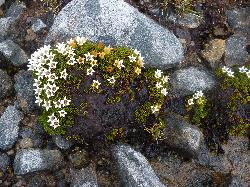- Taxon
- Gallery
Very densely branched herb with erect crowded stems up to c. 10 cm. tall; forming compact, often broad, cushions. Branches and branchlets very densely clad in white floccose hairs. Lvs densely imbricate, long-persistent, appressed, linear-subulate to ligulate, ± 5–10 mm. long, thick, coriac., obtuse, glossy, ± hirsute at base. Fls sessile, solitary, mostly terminal, 8–10 mm. diam.; receptacle ± hairy at base. Calyx c. 1 mm. long; lobes 5, acute, ovate to broad-triangular; petals 5, c. 2–3 mm. long, white, rather fleshy, ovate-oblong, obtuse. Stamens 2, short, adnate to styles at base; anthers extrorse. Styles 2, short, thick, recurved, connate towards base; stigma capitate. Ovules on pend. apical placentae. Capsule indehiscent, ± 5 mm. long.
[From: Allan (1961) Flora of New Zealand. Volume 1.]
Fruiting: Dec.–Mar.




